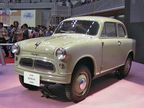Suzuki Models
4 CYCLE BIRDIE 50
ADDRESS
ADDRESS 110 WILD SHIELD SPEC
ADDRESS V100
ADDRESS V50
ADDRESS V 100
AERIO
AERIO SEDAN
AERIO SX
AERIO WAGON
ALTO
ALTO HUSTLE
ALTO LAPIN
AVENIS 150
BALENO
BANDIT
BANDIT 250V
CAPPUCCINO
CARRY TRUCK
CELERIO
CERVO
CHEVROLET CRUZE
CULTUS
CULTUS CRESCENT
CULTUS CRESCENT WAGON
CULTUS WAGON
DESPERADO
DJEBEL
DJEBEL 200
DR-2
DR250R
ESCUDO
ESTEEM
EVERY
EVERY LANDY
EVERY PLUS
EVERY WAGON
FORENZA
GOOSE
GRAND ESCUDO
GRAND VITARA
GRAND VITARA XL-7
GS
GSF
GSF1200S
GSF750
GSX-R
GSX-R750
GSX1300R HAYABUSA
GSX1400
Suzuki photos, specs - Car Pictures & Images
 Suzuki Motor Corporation (スズキ株式会社, Suzuki Kabushiki-gaisha?) is a multinational corporation headquartered in Hamamatsu, Japan that specializes in manufacturing compact automobiles, a full range of motorcycles, All-Terrain Vehicles (ATVs), outboard marine engines, wheelchairs and a variety of other small internal combustion engines. Suzuki is the 12th largest automobile manufacturer in the world by production volume, employs over 45,000 people, has 35 main production facilities in 23 countries and 133 distributors in 192 countries. |
Used Suzuki
"Suzuki" is pronounced in Japanese as "soo-zoo-kee" / suzuki/ , with emphasis on a high "kee". It is almost always pronounced in English as "suh-ZOO-kee" / səˈzuːki/ , with a stressed "zoo". This pronunciation is used by the English-speaking public and by the Suzuki company in marketing campaigns directed towards this demographic. In 1909, Michio Suzuki founded the Suzuki Loom Company in the small seacoast village of Hamamatsu, Japan. Business boomed as Suzuki built weaving looms for Japan's giant silk industry. In 1929, Michio Suzuki invented a new type of weaving machine, which was exported overseas. Suzuki filed as many as 120 patents and utility model rights. The company's first 30 years focused on the development and production of these exceptionally complex machines. Despite the success of his looms, Suzuki realized his company had to diversify and he began to look at other products. Based on consumer demand, he decided that building a small car would be the most practical new venture. The project began in 1937, and within two years Suzuki had completed several compact prototype cars. These first Suzuki motor vehicles were powered by a then-innovative, liquid-cooled, four-stroke, four-cylinder engine. It featured a cast aluminum crankcase and gearbox and generated 13horsepower (9.7kW) from a displacement of less than 800cc. With the onset of World War II, production plans for Suzuki's new vehicles were halted when the government declared civilian passenger cars a "non-essential commodity." At the conclusion of the war, Suzuki went back to producing looms. Loom production was given a boost when the U.S. government approved the shipping of cotton to Japan. Suzuki's fortunes brightened as orders began to increase from domestic textile manufacturers. But the joy was short-lived as the cotton market collapsed in 1951. Faced with this colossal challenge, Suzuki's thoughts went back to motor vehicles. After the war, the Japanese had a great need for affordable, reliable personal transportation. A number of firms began offering "clip-on" gas-powered engines that could be attached to the typical bicycle. Suzuki's first two-wheel ingenuity came in the form of a motorized bicycle called, the "Power Free." Designed to be inexpensive and simple to build and maintain, the 1952 Power Free featured a 36 cc two-stroke engine. An unprecedented feature was the double-sprocket gear system, enabling the rider to either pedal with the engine assisting, pedal without engine assist, or simply disconnect the pedals and run on engine power alone. The system was so ingenious that the patent office of the new democratic government granted Suzuki a financial subsidy to continue research in motorcycle engineering, and so was born Suzuki Motor Corporation. » Read More About Suzuki |






